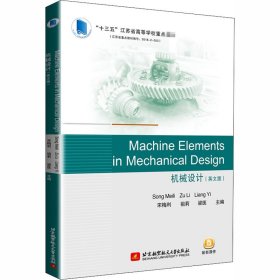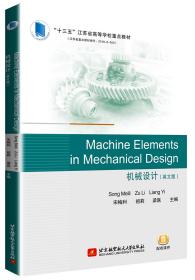
机械设计(英文版)
全新正版 假一赔十 可开发票
¥ 61.19 7.7折 ¥ 79 全新
库存5件
作者宋梅利,祖莉,梁医 主编
出版社北京航空航天大学出版社
ISBN9787512431485
出版时间2020-08
装帧平装
开本16开
定价79元
货号28982588
上书时间2024-10-17
- 最新上架
商品详情
- 品相描述:全新
- 商品描述
-
前言
According to the basic requirements of the mechanical design course issued by the Ministry of Education’s Mechanical Basic Course Teaching Steering Committee, combined with the current teaching reform and the requirements of mechanical innovation talent training, summed up the experience of teaching practice in recent years, this textbook is compiled.
“Machine Elements in Mechanical Design”is a technical basic course for mechanical, electromechanical, weapon, and power fields. The purpose of this book is to develop students’ mechanical system structural design capabilities and innovative design capabilities so that students can design high-speed, high efficiency, sophisticated and intelligent machines. Another goal is to cultivate internationally competitive, domestic and foreign, high-level mechanical talented persons.
The characteristics of this book are as follows:
- In order to strengthen students’ ability to connect theory with practice, this book pays attention to the introduction of the engineering application background of mechanical parts.
- The textbook is designed to cultivate students’overall and system concepts when they design a complicated machine, and to improve students’ comprehensive mechanical design ability.
- In order to facilitate students’ self-study and expand learning, examples and solution steps are spelled out in detail for important and commonly used machine elements, problems are provided in each chapter, some designing projects are also given.
- Complicated, lengthy calculations and formula derivation are simplified and avoided as much as possible, and basic principles, basic design ideas, structural features and application knowledge are highlighted.
- The latest national standards and specifications are used as much as possible.
We, Song Meili, Zu Li and Liang Yi, all have taught this course for undergraduate students for more than 15 years in Nanjing University of Science and Technology. Chapters 3, 4, 8, 14 and 15 are compiled by Song Meili, and chapters 2, 5, 7, 11 and 13 are written by Zu Li, chapters 1,6,9,10 and 12 are compiled by Liang Yi.
We are grateful to Nanjing University of Science and Technology as well as Beihang University Press for their support and publication. Special appreciation goes to our colleagues, Prof. Fan Yuanxun, Dr. Zhang Long ,Dr. Zhang Qing, Wang Feiyan and Wang Yanrong for their encouragement and support for this book.We also thank our students for their positive feedback about this book. Our appreciations are extended to all those who made helpful suggestions for improvements of this book.
Song Meili, Zu Li, and Liang Yi
Nanjing University of Science and Technology
January 18,2020
导语摘要his book is one of the excellent textbooks for colleges and universities of Jiangsu Province in 2018, which is based on the demand for mechanical engineering field in teaching reform. It is designed to be used as the basic course for the undergraduate students in mechanical design.
There are fifteen chapters in this book .Its coverage includes introduction;strength of mechanical parts;friction, wear and lubrication;threaded joints;axle and hub connections;rivetings,weldings and bondings;power screws;belt drives;chain drives;gear drives;worm gear transmission;shafts;sliding bearings;rolling-element bearings;couplings, clutches and brakes. Homework problems and projects involving design and analysis provide a basis for the course to follow. At the end, the text is supplemented by a glossary of terms.
This book can be used as textbooks for the course of machine elements in mechanical design or a reference for students, teachers and engineers specializing in mechanical engineering.
目录Chapter 1 Introduction 1
1.1 The Objectives and Tasks of the Course 1
1.2 Basic Requirements and Design Procedures 2
1.2.1 Basic requirements 2
1.2.2 Procedures for mechanical design 4
1.3 Failure Modes and Design Criteria 6
1.3.1 Failure modes of mechanical parts 6
1.3.2 Criteria for mechanical parts 6
1.4 Common Materials and Their Selection Principle of Mechanical Parts 8
1.4.1 Common materials of mechanical parts 9
1.4.2 Materials selection principle 11
1.5 Modern Mechanical Design Theories and Methods 12
Internet Resources 13
Problems 14
Chapter 2 Strength of Mechanical Parts 15
2.1 Introduction 15
2.2 Working Capacity Calculation Criteria for Mechanical Parts 16
2.2.1 Failure form of mechanical parts 16
2.2.2 Working capacity calculation criteria 16
2.3 Common Materials for Mechanical Parts and Their Selections 18
2.3.1 Common materials for mechanical parts 19
2.3.2 Principles for selecting mechanical parts materials 22
2.4 Load and Stress Acting on Parts 24
2.4.1 Classification of load 24
2.4.2 Classification of stress 24
2.5 Strength Calculation 25
2.5.1 Strength of mechanical parts under static stress 25
2.5.2 Fatigue strength calculation of mechanical parts 27
2.5.3 Contact strength of mechanical parts 32
Internet Resources 34
Problems 34
Chapter 3 Friction, Wear and Lubrication 36
3.1 Introduction 36
3.2 Friction 37
3.2.1 Dry friction 39
3.2.2 Boundary friction (boundary lubrication) 40
3.2.3 Mixed friction (mixed lubrication) 41
3.2.4 Fluid friction (fluid lubrication) 42
3.3 Wear 42
3.3.1 Typical wear process 42
3.3.2 Types of wear 43
3.4 Lubrication 45
3.4.1 Main properties of lubricants 46
3.4.2 Viscosity law 50
3.4.3 Introduction to fluid lubrication 51
Internet Resources 52
Problems 52
Chapter 4 Threaded Joints 53
4.1 Introduction 53
4.1.1 Thread formation 53
4.1.2 Types and applications of screw 53
4.1.3 Main parameters of the thread 56
4.2 Types of Threaded Joints and Standards 57
4.2.1 Types of threaded joints 57
4.2.2 Standard threaded couplings 59
4.3 Pre-tightening and Anti-looseness of Threaded Joints 61
4.3.1 Pre-tightening of threaded joints 61
4.3.2 Anti-looseness of threaded joints 64
4.4 Strength Calculation for the Single Threaded Joints 66
4.4.1 Strength calculation of loose bolt connections 66
4.4.2 Strength calculation of tight bolt connections 67
4.4.3 Material and allowable stress of threaded couplings 73
4.5 Design and Force Analysis of Bolt Group Connections 75
4.5.1 Structural design of bolt group connections 75
4.5.2 Force analysis of bolt group connections 76
Internet Resources 79
Problems 79
Machine Elements in Mechanical Design Project 82
Chapter 5 Axle and Hub Connections 83
5.1 Key Connections 83
5.1.1 Types and applications 83
5.1.2 Selection and the strength calculation 86
5.2 Spline Connections 90
5.2.1 The type, characteristics and application of spline connections 90
5.2.2 The strength calculation of spline connections 92
5.3 Pin Connections 93
Internet Resources 95
Problems 95
Project 95
Chapter 6 Rivetings,Weldings and Bondings 97
6.1 Rivetings 97
6.1.1 Rivet joints 97
6.1.2 Failure forms and design of rivetings 98
6.2 Weldings 99
6.2.1 Types, characteristics and applications of weldings 99
6.2.2 Failure modes of welding 99
6.2.3 Design of welding parts 100
6.3 Bondings 102
6.3.1 The applications of bondings 102
6.3.2 Adhesive joints 102
6.3.3 Adhesives 103
6.3.4 Comparisons of bondings, rivetings and weldings 104
Internet Resources 104
Problems 104
Chapter 7 Power Screws 105
7.1 Types, Characteristics and Applications of Power Screws 105
7.2 Sliding Power Screws 106
7.2.1 The structure of sliding power screws 106
7.2.2 Design calculation of sliding power screws 107
7.3 Ball Screws Drives 110
7.3.1 Structure types and characteristics 110
7.3.2 Design and calculation of ball screws drives 112
Internet Resources 113
Problems 113
Project 114
Chapter 8 Belt Drives 116
8.1 Types and Characteristics of Belt Drives 116
8.1.1 Working principle and characteristics of belt drives 116
8.1.2 Types and applications of belt drives 117
8.2 Analysis of Belt Drives 118
8.2.1 Force analysis of belt drives 118
8.2.2 Stress analysis of belts 120
8.2.3 Elastic slipping and creeping of belts 121
8.3 Design Calculation of Ordinary V-belt Drives 123
8.3.1 V-belt structur
相关推荐
— 没有更多了 —




















以下为对购买帮助不大的评价